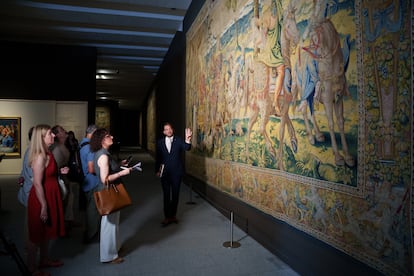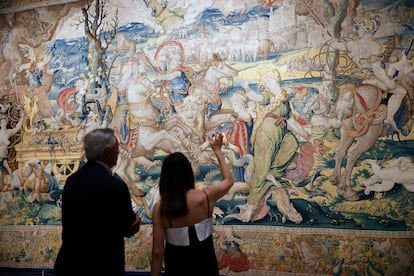The germ of what is today the gallery of the royal collections in Madrid was a museum project devised by the Government of Manuel Azaña during the Second Republic. It was a pavilion dedicated to the exhibition of tapestries and that also included the collection of real carriages. The project remained in that and never materialized. Already in June 2023, when the new gallery opened its doors – 20 years and three governments after its construction – did it with the first of its temporal exhibitions dedicated to the real carriages and with half a hundred vehicles belonging to national heritage. This Tuesday, like another wink to its embryo, the Madrid institution inaugurated the exhibition Iconography of evil. Tapices of capital sins, The first that Heritage dedicates to its collection of tapestries – about 3,200 pieces in total – “the most important in the world for its size and quality,” according to Víctor Cageao, director of the museum, and will be open until September 28.
To show off that huge collection and “also demonstrate the power that has national heritage and its ability to tell stories,” as Cageao explained in the presentation, the gallery has decided to expose 10 huge tapestries of the 16th century – between 7 and 8 meters long and another 4 high – silk and cotton and with silver and gold thread embroidery. Each represents one of the capital sins. They are works, explained the director, “of great relevance that had never been exposed together with scientific will.” They come from two different series, although the two designed by the Belgian painter Pieter Coecke van Aelst: one of the collection of María de Hungary – of which 4 – and another from the Count Egmont collection – of which 6. “This also implies a unique opportunity to compare the two series with each other,” Cageao said.
As a national heritage, Spanish royalty used the tapestries, centuries before, to show its power. “You have to remember that they were not only temporary objects, but emblems of power to show the richness of the monarchy. People were amazed with these structures so large and made with such noble materials,” said the conservative and commissioner of the exhibition, Roberto Muñoz, when entering the room.
Seeing the huge works hanging from its walls it becomes evident that their ability to amaze have preserved unalterable. The space, of 940 square meters, in which this summer will take refuge from the high temperatures, is very wide and allows to move away or approach them as much as it is pleased and without any visual obstacle. “We wanted them to have all the prominence and that they could see themselves very well, to recreate and see them calm. Many times they are exposed, but they are usually in the background,” explains the commissioner.
All of the sample are built with the same structure. “Hell opens at the top and a triumphal car appears where there is a woman who represents some of the capital sins. And then we also see characters of classical antiquity or the old testament related to those sins, forming a delegation that goes to a city,” explained the conservative and commissioner. In lust, for example, the city is Rome – “As far as it is,” Muñoz joked – in laziness Betulia and in the superb Babel. The characters also change, such as Hercules and Solomon in the representation of pride or cupid and Venus in lust. “This is born from a Renaissance tradition of placing the images in frieze and helps to see how it went from a theme in the classic Roman Greco tradition of the struggle between good and evil, a Catholic of the fight between sins and virtues,” said the commissioner.
Although the lack of clear signage prevents one of the objectives of the sample from being organized organically: the comparison between the two series. Of the 10 exposed tapestries, three couples repeat sin and show a practically the same image, with subtle differences. Couples do not share a wall, but are forming a triangle, and you have to make an effort to read the posters of the pair of works – separated by the complete extension of the two tapestries – which, only with the difference in the years of realization, show some distinction. The commissioner helps us find them: “They are not very noticeable. It shows above all in color and border, some much more elaborate than the others. There are only about ten years of difference between them and the designer is the same.”
Also, to “make an entertaining and fun exhibition,” Cageao said, the gallery has decided to divide the sample into thematic blocks. “We have divided into five parts that develop certain aspects that complement the definition, study or simply examine these pieces,” said the commissioner. They do it with the help of paintings, sculptures, books and documents, which exemplify the role that the tapestries had in the court and the artistic and social path that they traveled to create. Although these elements are not, much less, main agents of the sample.

As the gallery director said, “it is an exhibition that makes the building capabilities profitable.” The spectacular construction, somewhat hidden (built down and next to the Almudena Cathedral), was a public spending of 172 million euros. The sample that was presented on Tuesday is the great summer commitment of a museum that this June celebrates its second anniversary and has not had as good results as expected. The low assistance on a Tuesday in June, with free admission, checks it. While hundreds of tourists queue under the summer sun to enter the Royal Palace, the entrance of the gallery, overflowing with fresh air conditioning, barely finds a couple of people. Last year his halls received 648,209 visitors, about 1,776 a day. Little less than the 1,867 they received during their first six months of operation in the second half of 2023. To put it in context, a giant like El Prado last year reached about 9,471 visitors a day, Queen Sofía de Madrid about 5.370, the Thyssen about 2,307, or its neighbor, the Royal Palace, also dependent on National Heritage, 4,284.
“This sample is part of one of the objectives we have always had: to value the best jewels we guard and that make up our collections. And with this we maintain the intense activity that we proposed at the beginning,” said Ana de la Cueva, president of National Heritage, at the beginning of the presentation. The exhibition of the tapestries was the idea of Leticia Ruiz, the former director of the gallery, who left the position just over a year after launching the center. The objective of his successor, warned him in his presentation as director in March and with this new bet he intends to take steps, is clear: to make his own the first museum visit tourists when they arrive in Madrid.

